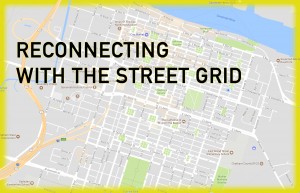It seems strange to most people that the idea of removing infrastructure could ever be a good thing. But in many cities, that’s exactly the case. Our excitement to build freeways in the 1950’s and beyond led us to build far more highway and road infrastructure than we needed or was wise. Entire neighborhoods were removed in order to serve commuters, and others were cut off because of the changes. Cities often thought that the only way to keep their downtowns vital was to accommodate high-speed roadways, exit ramps and abundant parking. Unfortunately, these changes almost universally hastened the demise of downtown areas since they destroyed the qualities that make them desirable in the first place. Cities thrive precisely because of their street grids, the diversity of travel options, the density of activity and prioritizing pedestrians.
So in that vein, it’s interesting to see that Rochester, NY, is now among cities that are correcting the mistakes of a previous era. From the
article below, here’s a key point to ponder as we consider our own development and transportation options in Savannah:
“We had a moat that separated the East Side neighborhood from downtown,” Rochester Mayor Lovely Warren told The New York Times. “Filling in the Inner Loop gives people the ability to more easily get around. It gives us more space to develop. Before this, businesses had to stop development. They had nowhere to go because of that highway.”
Now, the City of Rochester wants to fill in the northern section of the Inner Loop, which carries just 20,000-25,000 vehicles a day, and replacing it with a surface street—reconnecting the entire east and north side of downtown to nearby neighborhoods. Studies have shown that the majority of the traffic can absorb into the downtown street grid, which is well-equipped to handle the load.
It’s worth noting that our own I-16 exit ramp has vehicle counts also in the 20,000 range, which compares well with the Rochester example. And, the proposed ramp removal project not only reconnects the street grid, but opens up at least 8 acres of land for future development.

